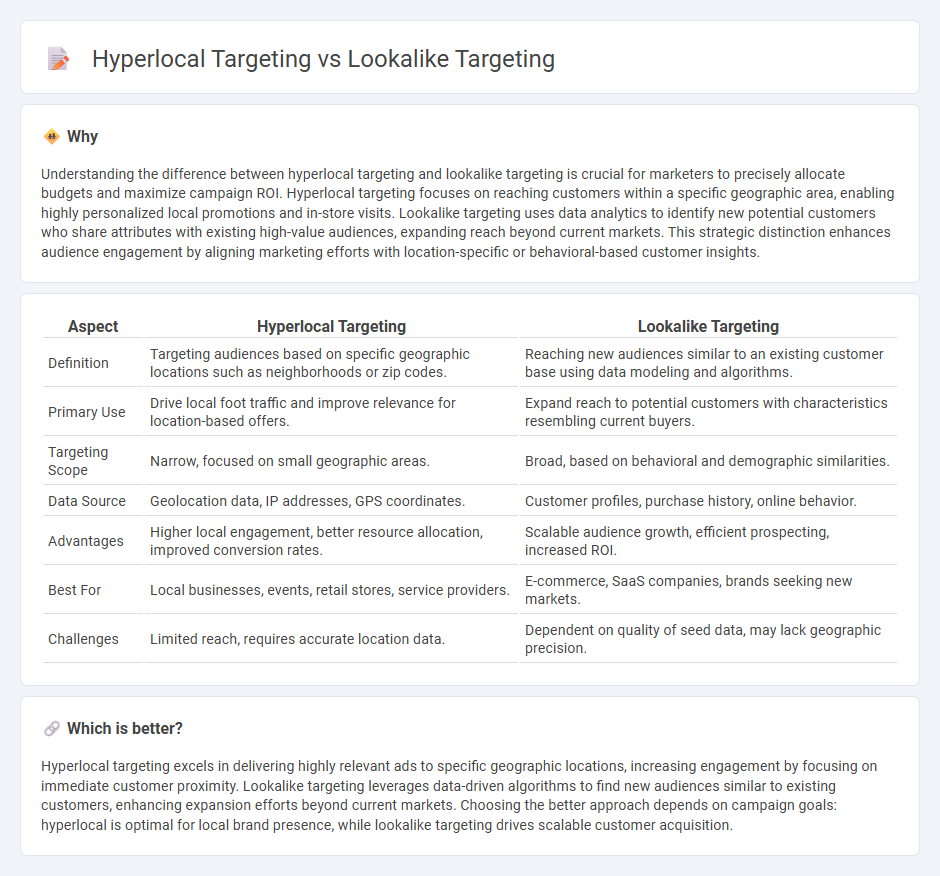
Hyperlocal targeting focuses on reaching potential customers within a specific geographic area, optimizing marketing efforts for localized demographics and behaviors. Lookalike targeting identifies new audiences that share similar characteristics with existing customers, leveraging data analytics to expand reach efficiently. Explore the advantages of both strategies to enhance your marketing campaigns.
Why it is important
Understanding the difference between hyperlocal targeting and lookalike targeting is crucial for marketers to precisely allocate budgets and maximize campaign ROI. Hyperlocal targeting focuses on reaching customers within a specific geographic area, enabling highly personalized local promotions and in-store visits. Lookalike targeting uses data analytics to identify new potential customers who share attributes with existing high-value audiences, expanding reach beyond current markets. This strategic distinction enhances audience engagement by aligning marketing efforts with location-specific or behavioral-based customer insights.
Comparison Table
| Aspect | Hyperlocal Targeting | Lookalike Targeting |
|---|---|---|
| Definition | Targeting audiences based on specific geographic locations such as neighborhoods or zip codes. | Reaching new audiences similar to an existing customer base using data modeling and algorithms. |
| Primary Use | Drive local foot traffic and improve relevance for location-based offers. | Expand reach to potential customers with characteristics resembling current buyers. |
| Targeting Scope | Narrow, focused on small geographic areas. | Broad, based on behavioral and demographic similarities. |
| Data Source | Geolocation data, IP addresses, GPS coordinates. | Customer profiles, purchase history, online behavior. |
| Advantages | Higher local engagement, better resource allocation, improved conversion rates. | Scalable audience growth, efficient prospecting, increased ROI. |
| Best For | Local businesses, events, retail stores, service providers. | E-commerce, SaaS companies, brands seeking new markets. |
| Challenges | Limited reach, requires accurate location data. | Dependent on quality of seed data, may lack geographic precision. |
Which is better?
Hyperlocal targeting excels in delivering highly relevant ads to specific geographic locations, increasing engagement by focusing on immediate customer proximity. Lookalike targeting leverages data-driven algorithms to find new audiences similar to existing customers, enhancing expansion efforts beyond current markets. Choosing the better approach depends on campaign goals: hyperlocal is optimal for local brand presence, while lookalike targeting drives scalable customer acquisition.
Connection
Hyperlocal targeting focuses on reaching customers within a highly specific geographic area, leveraging location data to deliver personalized ads that drive local engagement. Lookalike targeting uses data from these hyperlocal audiences to find new potential customers who exhibit similar behaviors and preferences, expanding the reach beyond the initial location. Combining hyperlocal insights with lookalike algorithms enhances marketing precision, ensuring campaigns attract both nearby leads and similar prospects elsewhere.
Key Terms
**Lookalike Targeting:**
Lookalike targeting leverages data from existing customer profiles to identify and reach new audiences with similar characteristics, significantly enhancing ad relevance and conversion rates. This strategy uses machine learning algorithms to analyze demographics, interests, and behaviors, enabling precise audience expansion beyond traditional boundaries. Discover how lookalike targeting can optimize your marketing campaigns and drive scalable growth.
Audience Segmentation
Lookalike targeting uses data-driven algorithms to identify new audiences resembling existing customers based on demographic and behavioral patterns, maximizing reach and conversion potential. Hyperlocal targeting narrows the focus to specific geographic areas, tailoring campaigns to local preferences, events, and cultural nuances, optimizing relevance for nearby consumers. Explore the detailed benefits and strategies of each audience segmentation approach to enhance your marketing effectiveness.
Predictive Modeling
Lookalike targeting leverages predictive modeling by analyzing existing customer data to identify new audiences with similar behaviors and characteristics, enhancing campaign efficiency and reach. Hyperlocal targeting uses predictive models to analyze geographic and demographic data, delivering highly relevant ads to users within a specific, narrowly defined area for increased engagement. Explore more about how predictive modeling transforms these targeting strategies to optimize marketing performance.
Source and External Links
Lookalike audience - Wikipedia - Lookalike targeting is a digital marketing tool that identifies new potential customers who share characteristics with an existing audience, helping advertisers expand reach efficiently with lower acquisition costs by analyzing common behavioral patterns of seed audiences, commonly used on platforms like Facebook, Google Ads, and LinkedIn.
What is a Lookalike (LAL) Audience? A Complete Guide - Salesforce - Lookalike targeting allows marketers to find new customers similar to their existing base and can be combined with demographic, interest-based, or behavioral targeting to refine and enhance campaign precision and performance measurement.
Use Lookalike segments to grow your audience - Google Ads Help - Lookalike segments use seed lists from first-party data to find people with similar attributes, enabling ads to reach potential customers with greater control over reach/similarity balance and continuously refreshed for up-to-date targeting.
 dowidth.com
dowidth.com